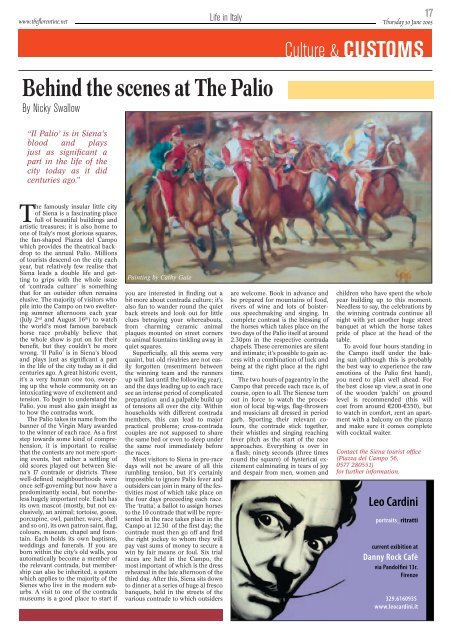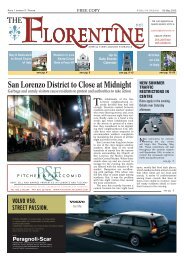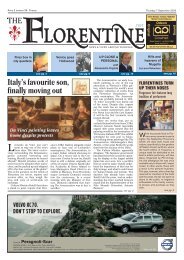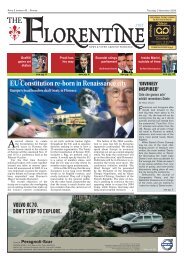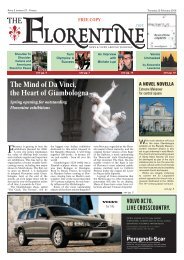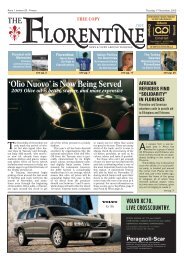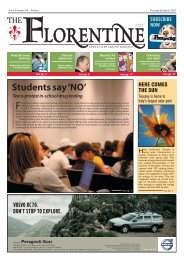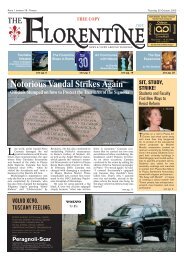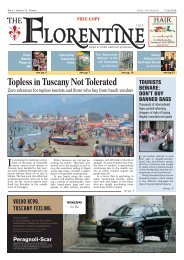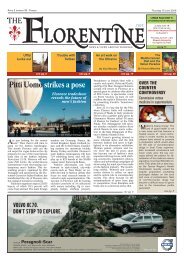NEWS - The Florentine
NEWS - The Florentine
NEWS - The Florentine
Create successful ePaper yourself
Turn your PDF publications into a flip-book with our unique Google optimized e-Paper software.
www.theflorentine.net<br />
Life in Italy<br />
17<br />
Thursday 30 June 2005<br />
Culture & CUSTOMS<br />
Behind the scenes at <strong>The</strong> Palio<br />
By Nicky Swallow<br />
“Il Palio’ is in Siena’s<br />
blood and plays<br />
just as significant a<br />
part in the life of the<br />
city today as it did<br />
centuries ago.”<br />
<strong>The</strong> famously insular little city<br />
of Siena is a fascinating place<br />
full of beautiful buildings and<br />
artistic treasures; it is also home to<br />
one of Italy’s most glorious squares,<br />
the fan-shaped Piazza del Campo<br />
which provides the theatrical backdrop<br />
to the annual Palio. Millions<br />
of tourists descend on the city each<br />
year, but relatively few realise that<br />
Siena leads a double life and getting<br />
to grips with the whole issue<br />
of ‘contrada culture’ is something<br />
that for an outsider often remains<br />
elusive. <strong>The</strong> majority of visitors who<br />
pile into the Campo on two sweltering<br />
summer afternoons each year<br />
(July 2 nd and August 16 th ) to watch<br />
the world’s most famous bareback<br />
horse race probably believe that<br />
the whole show is put on for their<br />
benefit, but they couldn’t be more<br />
wrong. ‘Il Palio’ is in Siena’s blood<br />
and plays just as significant a part<br />
in the life of the city today as it did<br />
centuries ago. A great historic event,<br />
it’s a very human one too, sweeping<br />
up the whole community on an<br />
intoxicating wave of excitement and<br />
tension. To begin to understand the<br />
Palio, you must also gain insight as<br />
to how the contradas work.<br />
<strong>The</strong> Palio takes its name from the<br />
banner of the Virgin Mary awarded<br />
to the winner of each race. As a first<br />
step towards some kind of comprehension,<br />
it is important to realise<br />
that the contests are not mere sporting<br />
events, but rather a settling of<br />
old scores played out between Siena’s<br />
17 contrade or districts. <strong>The</strong>se<br />
well-defined neighbourhoods were<br />
once self-governing but now have a<br />
predominantly social, but nonetheless<br />
hugely important role. Each has<br />
its own mascot (mostly, but not exclusively,<br />
an animal; tortoise, goose,<br />
porcupine, owl, panther, wave, shell<br />
and so on), its own patron saint, flag,<br />
colours, museum, chapel and fountain.<br />
Each holds its own baptisms,<br />
weddings and funerals. If you are<br />
born within the city’s old walls, you<br />
automatically become a member of<br />
the relevant contrada, but membership<br />
can also be inherited, a system<br />
which applies to the majority of the<br />
Sienes who live in the modern suburbs.<br />
A visit to one of the contrada<br />
museums is a good place to start if<br />
Painting by Cathy Gale<br />
you are interested in finding out a<br />
bit more about contrada culture; it’s<br />
also fun to wander round the quiet<br />
back streets and look out for little<br />
clues betraying your whereabouts,<br />
from charming ceramic animal<br />
plaques mounted on street corners<br />
to animal fountains tinkling away in<br />
quiet squares.<br />
Superficially, all this seems very<br />
quaint, but old rivalries are not easily<br />
forgotten (resentment between<br />
the winning team and the runners<br />
up will last until the following year),<br />
and the days leading up to each race<br />
see an intense period of complicated<br />
preparation and a palpable build up<br />
of tensions all over the city. Within<br />
households with different contrada<br />
members, this can lead to major<br />
practical problems; cross-contrada<br />
couples are not supposed to share<br />
the same bed or even to sleep under<br />
the same roof immediately before<br />
the races.<br />
Most visitors to Siena in pre-race<br />
days will not be aware of all this<br />
rumbling tension, but it’s certainly<br />
impossible to ignore Palio fever and<br />
outsiders can join in many of the festivities<br />
most of which take place on<br />
the four days preceeding each race.<br />
<strong>The</strong> ‘tratta’, a ballot to assign horses<br />
to the 10 contrade that will be represented<br />
in the race takes place in the<br />
Campo at 12.30 of the first day; the<br />
contrade must then go off and find<br />
the right jockey to whom they will<br />
pay vast sums of money to secure a<br />
win by fair means or foul. Six trial<br />
races are held in the Campo, the<br />
most important of which is the dress<br />
rehearsal in the late afternoon of the<br />
third day. After this, Siena sits down<br />
to dinner at a series of huge al fresco<br />
banquets, held in the streets of the<br />
various contrade to which outsiders<br />
are welcome. Book in advance and<br />
be prepared for mountains of food,<br />
rivers of wine and lots of boisterous<br />
speechmaking and singing. In<br />
complete contrast is the blessing of<br />
the horses which takes place on the<br />
two days of the Palio itself at around<br />
2.30pm in the respective contrada<br />
chapels. <strong>The</strong>se ceremonies are silent<br />
and intimate; it’s possible to gain access<br />
with a combination of luck and<br />
being at the right place at the right<br />
time.<br />
<strong>The</strong> two hours of pageantry in the<br />
Campo that precede each race is, of<br />
course, open to all. <strong>The</strong> Sienese turn<br />
out in force to watch the procession<br />
of local big-wigs, flag-throwers<br />
and musicians all dressed in period<br />
garb. Sporting their relevant colours,<br />
the contrade stick together,<br />
their whistles and singing reaching<br />
fever pitch as the start of the race<br />
approaches. Everything is over in<br />
a flash; ninety seconds (three times<br />
round the square) of hysterical excitement<br />
culminating in tears of joy<br />
and despair from men, women and<br />
children who have spent the whole<br />
year building up to this moment.<br />
Needless to say, the celebrations by<br />
the winning contrada continue all<br />
night with yet another huge street<br />
banquet at which the horse takes<br />
pride of place at the head of the<br />
table.<br />
To avoid four hours standing in<br />
the Campo itself under the baking<br />
sun (although this is probably<br />
the best way to experience the raw<br />
emotions of the Palio first hand),<br />
you need to plan well ahead. For<br />
the best close up view, a seat in one<br />
of the wooden ‘palchi’ on ground<br />
level is recommended (this will<br />
cost from around €200-€350), but<br />
to watch in comfort, rent an apartment<br />
with a balcony on the piazza<br />
and make sure it comes complete<br />
with cocktail waiter.<br />
Contact the Siena tourist office<br />
(Piazza del Campo 56,<br />
0577 280551)<br />
for further information.


